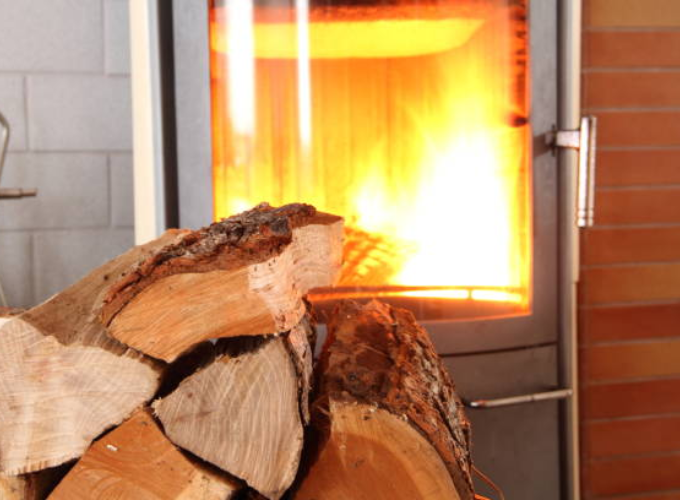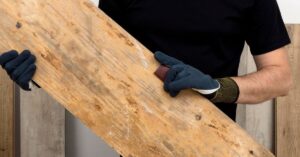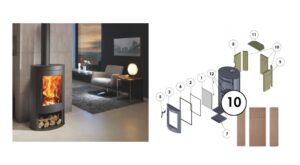
Although we enjoy the warmth of the fireplace, the odors can be unpleasant. With simple tricks like vinegar, salt, or baking soda, you can keep your home fresh and cozy.

In a previous blog, we discussed what the ideal temperature for your home is and the benefits of choosing it correctly. Well, in this blog, we will explore a series of recommendations to help you calibrate the perfect temperature in your home with a wood stove and ensure it stays as needed throughout the day.

A wood stove is a cozy and efficient source of heat that can provide warmth and comfort to your home during the cold winter months. However, to make the most of its potential, it is essential to learn how to calibrate the temperature properly. To do so, there are several steps to consider.
Before you start, it’s important to note that not all wood stoves are the same. When selecting one, opt for a stove that fits the size of the room you want to heat. Smaller stoves are ideal for more compact spaces, while larger stoves are suitable for larger areas.
Ensure that the stove is in good condition and clean before lighting it. Use dry and quality wood, preferably hardwood, as it produces more heat and fewer ashes. Avoid using treated or painted wood, as it can release toxic chemicals when burned.
Light the stove using an appropriate technique, such as the “roof” or “pyramid” method with firelighters and small branches. As the fire develops, adjust the airflow. Open the ventilation dampers to increase the temperature and partially close them to reduce it. This will help you control the heat intensity.
Continuous monitoring is essential for accurate temperature calibration. Use a stove thermometer or an ambient thermometer near the stove to monitor the temperature. Adjust the airflow as necessary to maintain the desired temperature.
The accumulation of ashes and soot can affect the stove’s efficiency. Regularly clean the combustion chamber and the chimney flue. A clean flue allows heat to radiate more efficiently in the room.
Remember that safety is paramount. Never leave the stove unattended, and make sure you have a carbon monoxide detector in your home to prevent poisoning issues. Additionally, maintain a safe distance between the stove and any flammable objects.
With all these preparatory steps, the next will be to obtain the tools that will help you calibrate the temperature.
A stove fan, also known as a heat-powered fan, is an accessory that utilizes the stove’s heat to distribute warm air more evenly throughout the room. Placed on top of the stove, this device activates automatically when a certain temperature is reached, enhancing the stove’s thermal efficiency. This means you can maintain the desired temperature with less effort and greater comfort.
A stove thermostat is a useful tool that allows you to control the temperature more precisely. You can set the desired temperature, and the thermostat will automatically adjust the airflow in the stove to keep it constant. This reduces the need for manual adjustment of the ventilation dampers and ensures a more comfortable environment in your home.
Wood heating can dry the air inside your home, which can be uncomfortable. To counteract this effect, consider using a stove humidifier. Place a water container on top of the stove or use a humidifier specifically designed for wood stoves. This will help maintain humidity in the air and provide a healthier and more comfortable environment.
For even more precise control of the temperature and humidity in your home, use an ambient thermometer and a humidity monitor. These devices will allow you to know the exact conditions in your home and adjust the stove accordingly.
To maximize the efficiency of your wood stove, ensure that your home is well insulated. Additionally, consider using thermal curtains to retain heat and block cold drafts. This will reduce the stove’s workload and help you maintain a constant temperature.
Another useful indicator for regulating airflow is to observe the color of the flames. Blue flames indicate that the stove is operating efficiently and using the correct amount of oxygen. If you see yellow or orange flames, it means there is an excess of oxygen or the wood is not burning efficiently. Adjust the airflow until you see blue flames.
When you open the air vents, you allow more oxygen to enter the fire. This increases the wood combustion rate and, as a result, raises the room temperature more quickly. Airflow increases, known as a “strong draft.” This action is useful when you need to heat the room quickly, such as when lighting the stove for the first time or when the house temperature is too low. However, be careful not to overheat the stove, as too strong a draft can waste wood and cause excessive heat.
Conversely, when you close the air vents, you restrict the oxygen flow to the fire. This reduces the wood combustion rate and, consequently, lowers the room temperature. The draft becomes weaker. Partially closing the air vents is useful when you want to maintain a constant temperature and prevent the stove from getting too hot.
In summary, achieving temperature control in a wood stove is essential by following key advice. Start by selecting a suitable stove and using quality wood. Learn to adjust the airflow by opening or closing the vents to control the temperature. The use of accessories such as fans and thermostats provides greater comfort. Additionally, it is crucial to keep the stove and chimney clean while ensuring safety at all times.
If you have any questions, please feel free to ask us! We hope this post has served as a guide. Take a look at our blog and find solutions and recommendations to help you with your fireplace or wood stove.
Visit our online store for Panadero wood stoves. If you have any questions or need help choosing the right stove, don’t hesitate to contact us. We will be happy to help you.
Articles of interest:
Did you like this article? If so, help us spread it 😊 . Click on the buttons below here and feel free to share it on your social networks!
Thank you for reading!
↓ ↓ ↓ ↓

Although we enjoy the warmth of the fireplace, the odors can be unpleasant. With simple tricks like vinegar, salt, or baking soda, you can keep your home fresh and cozy.

How to avoid dust in the house when using a wood stove: tips and tricks for a clean and healthy home

Learn how to remove mould from your wood for use by following the steps in this article.

All you need to know: what it is, uses and benefits of wood stoves
To provide the best experiences, we use technologies such as cookies to store and/or access device information. Consenting to these technologies will allow us to process data such as browsing behavior or unique identifiers on this site. Not consenting or withdrawing consent may adversely affect certain features and functions.

From December 19 to January 6, order a wood stove and receive the Helix log holder for free.